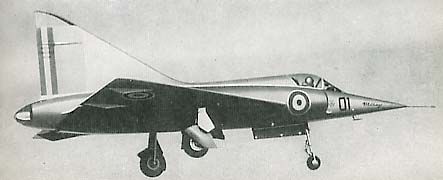Mirage I / MD-550 Mystère Delta
Summary
| Category | Combat Aircraft |
| Origin country | 🇫🇷 France |
| Manufacturer | Dassault |
| First flight | 25 June 1955 |
| Year introduced | 1961 |
| Number produced | 1422 units |
| Average unit price | $12 million |
Description
The Dassault Mirage III family traces its origins to studies by the French Defence Ministry in 1952, prompted by international interest in lightweight fighter designs after the Korean War. The French government's specification called for an all-weather interceptor, leading Dassault Aviation, Sud-Est, and Sud-Ouest to offer competitive designs. Dassault's MD.550 Mystère Delta, initially powered by two Armstrong Siddeley MD30R Viper afterburning turbojet engines and later fitted with a SEPR rocket engine, underwent flight testing in 1954, attaining speeds up to Mach 1.6. Limitations on endurance and equipment/payload capacity, including armament restricted to a single air-to-air missile, prompted a shift towards a larger aircraft powered by the newly developed Snecma Atar afterburning turbojet engine, resulting in the Mirage III. The first major production model, the Mirage IIIC, conducted its maiden flight in October 1960, and initial operational deliveries to the French Air Force commenced in July 1961.
The Mirage III was a family of single/dual-seat, single-engine fighter aircraft featuring a tailless delta configuration with a 5 per cent thickness ratio and 60° sweep, complete with a large vertical stabilizer and rudder. The tailless delta configuration imposed limitations, including the lack of a horizontal stabilizer, which precluded the use of conventional flaps, resulting in relatively long takeoff runs and high landing speeds. The delta wing configuration limits maneuverability and can exhibit buffeting at low altitude due to its large area and resulting low wing loading. However, the delta is a simple, robust design offering generous internal volume for fuel tankage and is capable of high speeds in straight-line flight. The Mirage III incorporated design principles such as the transonic area rule concept, optimizing cross-sectional changes for gradual transitions.
The Mirage IIIC was armed with twin 30 mm DEFA cannon fitted in the belly with the gun ports under the air intakes. Early production Mirage IIICs had three stores pylons, one under the fuselage and one under each wing; another outboard pylon was soon added to each wing, for a total of five. A sleek supersonic tank could also carry bombs. The outboard pylons were intended for AIM-9B Sidewinder air-to-air missiles, later replaced by the Matra R550 Magic, and the aircraft could carry the radar-guided Matra R530 missile on the center line pylon. The Mirage IIIE could carry 4,000 kg (8,800 lb) of payload on five external hardpoints, including a variety of bombs, reconnaissance pods, or drop tanks; French Air Force IIIEs through to 1991 were equipped to carry the AN-52 nuclear bomb.
The Mirage III has been used in active combat roles by numerous operators. The Israeli Air Force deployed their Mirage IIIs in the Six-Day War as both an air superiority and strike aircraft, and in the Yom Kippur War exclusively for air-to-air combat alongside the IAI Nesher. During the South African Border War, the Mirage III constituted the bulk of the South African Air Force's fleet, comprising Mirage IIICZ interceptors, Mirage IIIEZ fighter-bombers, and Mirage IIIRZ reconnaissance fighters. Following the introduction of the Mirage F1, the type was dedicated to secondary roles such as daytime interception, base security, reconnaissance, and training. The Argentine Air Force utilized the Mirage IIIEA during the Falklands War; however, the aircraft's lack of aerial refueling capability limited its operational effectiveness in the conflict.
Main Variants:
-
Mirage IIIC: The first major production model, a single-seat interceptor equipped with the Atar 09B turbojet engine and twin 30 mm DEFA cannons, with operational deliveries commencing in July 1961.
-
Mirage IIIB: A two-seat operational trainer variant developed in parallel with the Mirage IIIC, featuring a stretched fuselage and capable of carrying external stores.
-
Mirage IIIE: A multirole/strike variant with a longer forward fuselage to accommodate additional avionics and fuel, equipped with the Thomson-CSF Cyrano II dual-mode air/ground radar and the Atar 09C engine.
-
Mirage IIIR: A dedicated reconnaissance variant with a camera nose housing up to five OMERA cameras, retaining the DEFA cannons and external stores compatibility but lacking a radar system.
-
Mirage IIIO: An Australian-built variant based on the Mirage IIIE, differing mainly in its avionics, and manufactured in interceptor, surface attack, and twin-seat trainer versions.
Technical specifications
| Version: Mirage I | |
|---|---|
| Crew | 1 pilot |
| Maximum speed | 1700 km/h (1056 mph) |
| Wing area | 27.1 m² (291.7 sqft) |
| Wingspan | 7.3 m (24.0 ft) |
| Length | 12.8 m (42.0 ft) |
| Service ceiling | 14,600 m (47,900 ft) |
| Empty weight | 3,610 kg (7,959 lbs) |
| Max. takeoff weight | 5,150 kg (11,354 lbs) |
| Powerplant | 2 x turbojets Dassault MD-30R delivering 980 kgf each |
| Ejection seat | Martin-Baker Mk 4 |
Current operating countries
All operators
